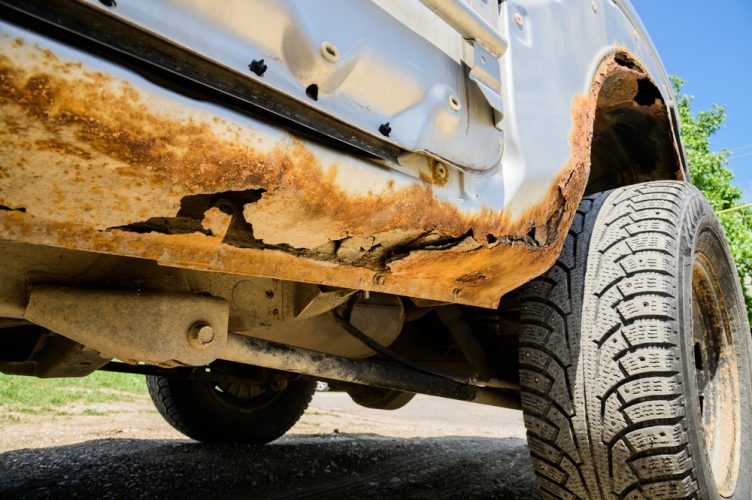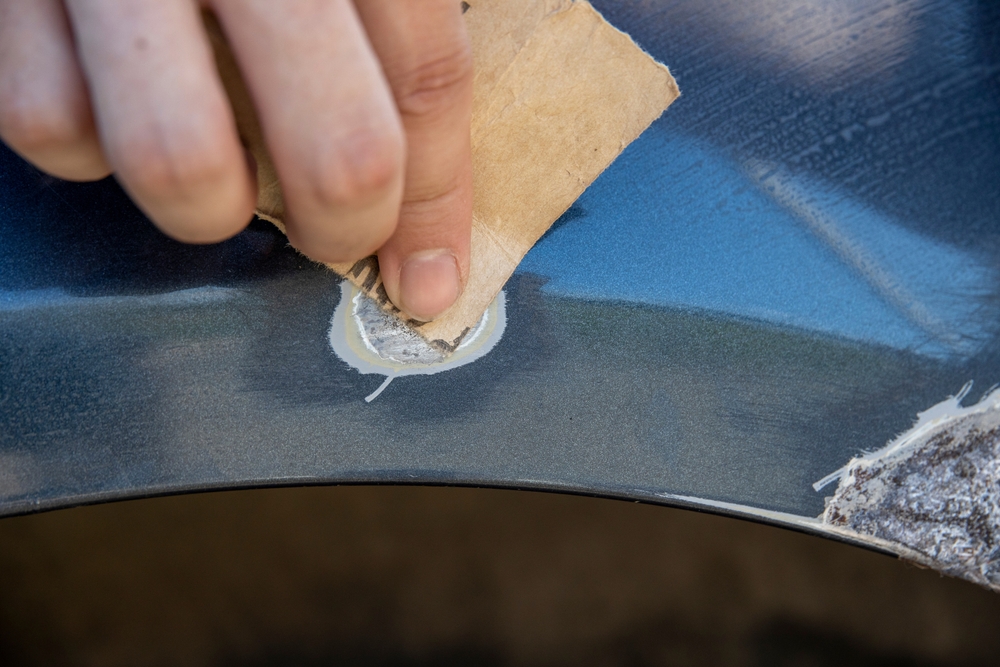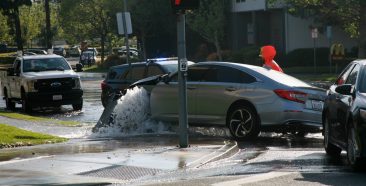
You’re looking at your car that has served you well for several – or more – years and thinking it looks pretty good for its age. You’re happy with your car insurance costs since your ride is paid for and affordable. But wait, what is that spot near the bumper on the left side? You go closer, run your fingers over it and realize it’s a rust spot!
Before you get frantic, understand that all items made from iron, such as the steel body panels on your prized possession, are eventually going to go through this process. Catching it early means you can likely fix it yourself before it spreads and causes more problems.
What is Rust?
It is a chemical reaction that happens when iron interacts with oxygen and converts into iron oxide. Iron oxide looks like a red, flaky substance and it will spread. Since we cannot get away from oxygen, and most vehicles today are built with a combination of iron and carbon, which forms steel, this is a common byproduct.
You’ll find steel in about 65 percent of your vehicle, including parts of the steering, suspension, body, wheels, chassis and frame. That’s a lot of places where iron oxide can form. Luckily, we’ve come a long way since the 1970s, when automakers used a cheaper version of steel. As a result, automobiles began exhibiting telltale signs of iron oxide almost as soon as they became available to buy.
Today’s automakers are constantly tinkering with new combinations of components to make it less likely that your car will dissolve in front of your eyes. Adding aluminum, magnesium, nickel and chromium to the iron base can slow the natural degradation process down. Today’s steel comes from the plant with a coating designed to slow down the effects of degradation. Modern vehicles are also given a bath in anti-corrosion agents before painting.
However, if you are the type of owner who likes to keep their vehicle for many years, you need to be vigilant with your maintenance. Nothing is foolproof against this natural process.
Factors that Cause Rust Damage on a Car
As we mentioned, the mere interaction with oxygen can cause it to begin forming on steel and other iron byproducts. But there are some things that can hasten the process, as well as steps people can take to slow the process down.
In some parts of the United States, the normal environment may have a lot to do with it. Even sunny and dry areas of the country will eventually see a breakdown in the protective coating after prolonged exposure to UV rays.
But salt and cold can really hasten it. In the north, salt is used extensively on the roads to help make traveling safer during winter months. People who live near saltwater, such as the beach or on the coast, deal with salt air corrosion.
Salt in the Environment
When the road salts begin to dissolve as temps climb, it becomes an electrolyte. Electrolytes are known to speed up chemical processes, which enables damage to happen faster. Seawater salt is just insidious. It’s always present in the environment and can become a corrosive force even as far as 50 miles inland.
Whether you live in the north or on the coast, you can help slow this process down by rinsing your vehicle often. Northerners drive through a slushy mix of dissolved salt and other particles that can get trapped within the parts of the auto. People who enjoy those saltwater breezes also need to wash and rinse everything they own that is composed of steel and other metals to slow down the process.

How to Avoid It
You can do a lot to avoid the issue by just washing and rinsing your vehicle on a regular basis and maybe more frequently in the winter. In fact, many of today’s car washes have special tools for cleaning the undercarriage, which is just as important as the visible areas when dealing with corrosion.
If you are buying a used car, be sure and check everywhere for tell-tale signs of corrosive damage.
How to Fix Rust on a Car
As we mentioned, being vigilant – especially if your ride is “of a certain age” – is key. There are three stages experts use to describe the process: Surface, scale and penetrating. You’ll want to catch it early for the cheapest DIY fix, as well as to prevent further damage.
Surface Rust Damage on Your Vehicle
This is the easiest to fix and may first be spotted in places where the paint has been scratched or in cracks. Here are the steps to fix the issue.
- Remove the paint and corrosion on the affected area with sandpaper (or an abrasive tool or sanding block if you have one) until you see clean metal. Wipe the area with warm soapy water and dry.
- Apply a rust repair inhibitor, which helps to convert iron oxide into a more stable and resistant compound.
- With protective gloves, apply a rust repair converter in a thin layer. Pour your converter into a disposable container rather than double-dipping from the bottle (accidentally getting rust in the bottle will ruin the contents). Wait 15-30 minutes for it to dry before adding a second layer and giving it a good 30 minutes to dry.
- Apply primer and allow to dry for 24 hours.
- Paint and clear coat, then buff. If the spot is not in a visible area, you can skip this step.
Scale Rust
At this point, you may be dealing with damage that can compromise the metal strength, so it’s imperative that you take steps to repair the surface. This type of iron oxide leads to an exposure of the base metal, which is then vulnerable to corrosion.
Use a wire brush to get through the damage, then a grinding wheel and sandpaper to get to bare metal in the repair area. Make sure the area is rough so your sealant will stick. If your spot is in a non-visible place, you can seal it up with a converter and be done.
If your spot is in a visible place, you may want to smooth it out in the next step with a body filler, such as Bondo. Keep in mind, body filler hardens quickly, so you’ll want to only mix as much as you think you will use within 10 minutes. Spread it on with a utensil and leave a little on the top for sanding. Let your filler fully dry for 30 minutes before moving on to the next step.
Smooth out the top and add an inhibitor (make sure it is compatible with your filler) and seal with primer. Paint and clear coat, the buff.
Pro Tip: You can find the paint code for your auto at a site such as Automotive Touchup. Purchase both the base coat and clear coat in small, touch up paint quantities. Unless you are a pro with a paint gun, use an aerosol spray or let a professional help you with the paint job.
Penetrating Rust
When the problem reaches this stage, you’ll see actual holes in the metal and it becomes brittle. If left untreated, it could lead to a dangerous situation, such as a weakened frame. This actually is not an easy, cheap DIY fix, unfortunately.
You shouldn’t attempt to fill these holes with body filler. You can replace the entire part or panel or you can cut the affected parts out and weld patches into place.
Neither one of these options should be done by an amateur. In fact, you should probably let the skilled professionals at a body shop do the work. Keep in mind that when you’ve got this issue, you may have a compromised automobile – and that’s a serious safety hazard. Let the pros handle it.
What Does it Cost to Fix Rust on a Car?
If you catch it early enough, you’ll be out a little bit of money for some supplies, plus your time. It’s definitely worth it to fix the damage while in the early stages. If you don’t and it moves into the later stages, it may not be worth the cost to fix it, depending on the age and value of your ride.
Stay on Top of Important Auto Maintenance with Affordable Insurance
Although your auto insurance policy won’t cover damage caused by negligence or the environment, you still need to have an affordable plan to drive legally. Freeway can help with that. Get a fast and free online quote, call us at (800) 777-5620 or stop in one of our convenient locations today.


